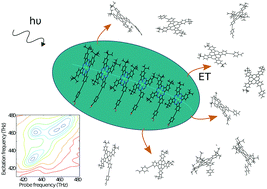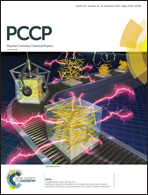Understanding the influence of disorder on the exciton dynamics and energy transfer in Zn-phthalocyanine H-aggregates†
Abstract
The photophysics of 9(19),16(17),23(24)-tri-tert-butyl-2-[ethynyl-(4-carboxymethyl)phenyl]phthalocyaninatozinc(II) and its H-aggregates is studied in different solvents by means of ultrafast non-linear optical spectroscopy and computational modeling. In non-coordinating solvents, both stationary and time-resolved spectroscopies highlight the formation of extended molecular aggregates, whose dimension and spectral properties depends on the concentration. In all the explored experimental conditions, time-resolved transient absorption experiments show multi exponential decay of the signals. Additional insights into the excited state relaxation mechanisms of the system is obtained with 2D electronic spectroscopy, which is employed to compare the deactivation channels in the absence or presence of aggregates. In ethanol and diethylether, where only monomers are present, an ultrafast relaxation process among the two non-degenerate Q-states of the molecule is evidenced by the appearance of a cross peak in the 2D-maps. In chloroform or CCl4, where disordered H-aggregates are formed, an energy transfer channel among aggregates with different composition and size is observed, leading to the non-radiative decay towards the lower energy dark state of the aggregates. Efficient coupling between less and more aggregated species is highlighted in two-dimensional electronic spectra by the appearance of a cross peak. The kinetics and intensity of the latter depend on the concentration of the solution. Finally, the linear spectroscopic properties of the aggregate are reproduced using a simplified structural model of an extended aggregate, based on Frenkel Hamiltonian Calculations and on an estimate of the electronic couplings between each dimer composing the aggregate computed at DFT level.



 Please wait while we load your content...
Please wait while we load your content...